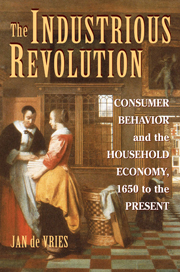Book contents
- Frontmatter
- Contents
- List of Figures
- Preface and Acknowledgments
- 1 The Transformation of Consumer Desire in the Long Eighteenth Century
- 2 The Origins of the Industrious Revolution
- 3 The Industrious Revolution: The Supply of Labor
- 4 The Industrious Revolution: Consumer Demand
- 5 The Breadwinner–Homemaker Household
- 6 A Second Industrious Revolution?
- Bibliography
- Index
3 - The Industrious Revolution: The Supply of Labor
Published online by Cambridge University Press: 05 June 2012
- Frontmatter
- Contents
- List of Figures
- Preface and Acknowledgments
- 1 The Transformation of Consumer Desire in the Long Eighteenth Century
- 2 The Origins of the Industrious Revolution
- 3 The Industrious Revolution: The Supply of Labor
- 4 The Industrious Revolution: Consumer Demand
- 5 The Breadwinner–Homemaker Household
- 6 A Second Industrious Revolution?
- Bibliography
- Index
Summary
Is it possible to marshal sufficient historical evidence to render plausible the proposition that households worked more and worked harder in the course of the long eighteenth century? And further, can it be shown empirically that these household members – on their pilgrimage from a leisure-rich society to one inured to constant labor – were motivated in their industrious behavior more by new consumption aspirations than by bitter necessity? That is, can it be shown that households worked more in order to consume more, and consume differently? These are the questions that will concern us in this chapter.
Pre-history of the Industrious Revolution
How the peasant lost his leisure time. In the study of predominantly agrarian societies, production is generally seen as the result of the interaction of labor, land, and technology. If technology is slow to change and available land is fixed in quantity, the addition of progressively more labor quickly faces diminishing returns. At the societal level this raises the specter of inadequate food supply as population grows. Thomas Robert Malthus expressed this as an inherent propensity for population to grow faster than food supply. Population, he reasoned, had the capacity to grow exponentially while food supply could grow, at best, arithmetically, a situation that would lead inexorably to recurring subsistence crises unless population growth could be held in check by other means.
- Type
- Chapter
- Information
- The Industrious RevolutionConsumer Behavior and the Household Economy, 1650 to the Present, pp. 73 - 121Publisher: Cambridge University PressPrint publication year: 2008



